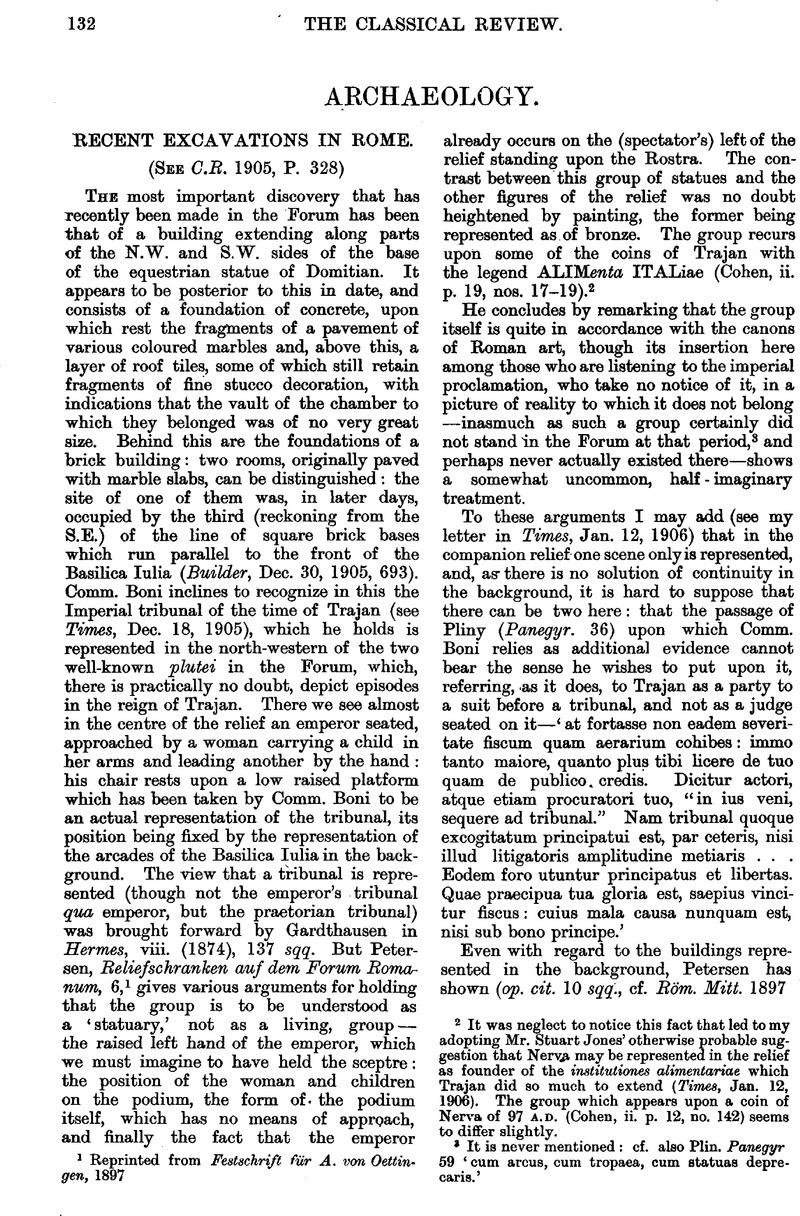No CrossRef data available.
Article contents
Archaeology
Published online by Cambridge University Press: 27 October 2009
Abstract

- Type
- Other
- Information
- Copyright
- Copyright © The Classical Association 1906
References
page 132 note 1 Reprinted from Festschrift für A. von Oettingen, 1897
page 132 note 2 It was neglect to notice this fact that led to my adopting Mr. Stuart Jones' otherwise probable suggestion that Nervs' may be represented in the relief as founder of the instituliones alimentariae which Trajan did so much to extend (Times, Jan. 12, 1906). The group which appears upon a coin of Nerva of 97 A.D. (Cohen, ii. p. 12, no. 142) seems to differ slightly.
page 132 note 3 It is never mentioned: cf. also Plin. Panegyr 59 ‘ cum arcus, cum tropaea, cum statuas deprecaris.’
page 133 note 1 It seems to have been a building of some size: we hear of its restoration by Antoninus Pius after fire, and of its burning in the fire of Carinus (Hist. Aug. Vita Pii, 8; Chronogr. a. 354, p. 148, ed. Mommsen).
page 133 note 2 Apollotempel auf dem Marsfelde, 11 and Taf. ii. 1.
page 134 note 1 He points out that if the tomb of Romulus is placed exactly in the centre of the semicircle, and not approximately so, as in Petersen's plan, matters become still worse. I may add that one would surely suppose that the straight ends of the curve ought to be in the same straight line, i.e. parallel to the front of the Curia, which, again, would tend to reduce the space available. It is difficult, too, to believe that the actual platform on which the speaker stood could have been so small as, if his view be accepted, it must have been—cf. the objections of Hälsen and Studniczka (the latter in Jahreshefte des Oesterr. Institute, 1904, 241).
page 134 note 2 This is a point that Hülsen does not make. Studniczka supposes that it originally extended further not on the S.E. (generally known as E.) side but on the S.W. (generally known as W.), and Hülsen does not seem to distinguish his view from that of Petersen (Jahreshefte 1903, 129 Jin. 130 init.).
page 134 note 3 Possibly three, but certainly not less.
page 135 note 1 On p. 22 (cf. 27) he identifies as a part of a balustrade enclosing this space on the Comitium side, a slab which he describes as of tufa (m in his Fig. 5 and PI. I.) which seems to be undoubtedly of travertine.
page 135 note 2 This point is missed by Petersen (op. cit. 14). The extremities of two other blocks are visible—one was certainly bossed, while of the other very little remains.
page 135 note 3 It is much more than a pity that none of Pinza's plans are provided with a scale.
page 135 note 4 It is a question how far his theory will agree with the tufa foundations—not now so easy to study as when first excavated (C.R. 1899, 233)—which lie immediately to the S.E. of the arch of Septimius Severus, and of whioh no plan has yet been published.
page 135 note 5 In this period alone the orientation of the Curia was changed, according to Pinza's theory.
page 135 note 6 The three passages he cites for these restorations (Dio Cass. xl. 49, xlii. 18; Appian, Bell. Civ. 97) prove nothing. The first describes the burning of the body of Clodius and of the Curia with it, the second the removal of the statue of Sulla from the rostra after the battle of Pharsalus, and the third the erection of this statue.
page 137 note 1 Thus in Thucydides a talent a month a ship (vi. 8) makes a drachm a day a man (vi. 31), and in Xenophon (Hell. i. 5) thirty mnas a month a shipmakes three obols a day a man.
page 137 note 2 The 200 oars were 62 thranite, 54 zygite, 54 thalamite, and 30 perineōi.
page 137 note 3 See, for instance, C.I.A. vol. ii. no. 808, col. b,. 11. 1 ff.
page 137 note 4 For the admiral's lantern see Xenophon, Hell. v. 1. 8; Diodoros, xx. 75; Appian, de bel. civ, ii. 89; Livy, xxix. 25; Procopios, de bel. Vand. i. 13.




